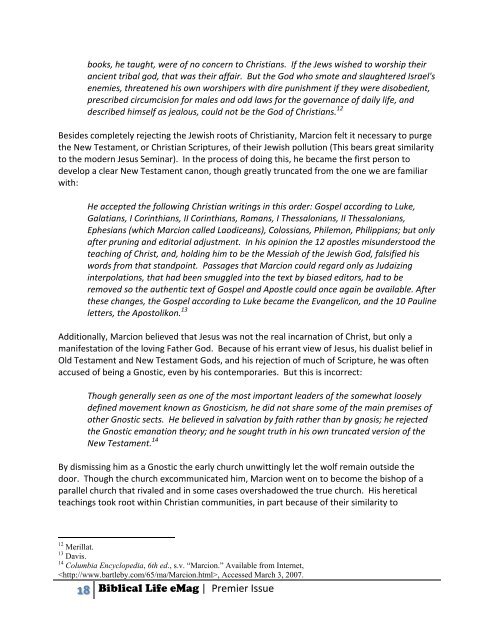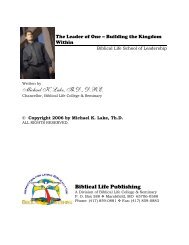Biblical Life eMag - Biblical Life College & Seminary
Biblical Life eMag - Biblical Life College & Seminary
Biblical Life eMag - Biblical Life College & Seminary
Create successful ePaper yourself
Turn your PDF publications into a flip-book with our unique Google optimized e-Paper software.
ooks, he taught, were of no concern to Christians. If the Jews wished to worship their<br />
ancient tribal god, that was their affair. But the God who smote and slaughtered Israel's<br />
enemies, threatened his own worshipers with dire punishment if they were disobedient,<br />
prescribed circumcision for males and odd laws for the governance of daily life, and<br />
described himself as jealous, could not be the God of Christians. 12<br />
Besides completely rejecting the Jewish roots of Christianity, Marcion felt it necessary to purge<br />
the New Testament, or Christian Scriptures, of their Jewish pollution (This bears great similarity<br />
to the modern Jesus Seminar). In the process of doing this, he became the first person to<br />
develop a clear New Testament canon, though greatly truncated from the one we are familiar<br />
with:<br />
He accepted the following Christian writings in this order: Gospel according to Luke,<br />
Galatians, I Corinthians, II Corinthians, Romans, I Thessalonians, II Thessalonians,<br />
Ephesians (which Marcion called Laodiceans), Colossians, Philemon, Philippians; but only<br />
after pruning and editorial adjustment. In his opinion the 12 apostles misunderstood the<br />
teaching of Christ, and, holding him to be the Messiah of the Jewish God, falsified his<br />
words from that standpoint. Passages that Marcion could regard only as Judaizing<br />
interpolations, that had been smuggled into the text by biased editors, had to be<br />
removed so the authentic text of Gospel and Apostle could once again be available. After<br />
these changes, the Gospel according to Luke became the Evangelicon, and the 10 Pauline<br />
letters, the Apostolikon. 13<br />
Additionally, Marcion believed that Jesus was not the real incarnation of Christ, but only a<br />
manifestation of the loving Father God. Because of his errant view of Jesus, his dualist belief in<br />
Old Testament and New Testament Gods, and his rejection of much of Scripture, he was often<br />
accused of being a Gnostic, even by his contemporaries. But this is incorrect:<br />
Though generally seen as one of the most important leaders of the somewhat loosely<br />
defined movement known as Gnosticism, he did not share some of the main premises of<br />
other Gnostic sects. He believed in salvation by faith rather than by gnosis; he rejected<br />
the Gnostic emanation theory; and he sought truth in his own truncated version of the<br />
New Testament. 14<br />
By dismissing him as a Gnostic the early church unwittingly let the wolf remain outside the<br />
door. Though the church excommunicated him, Marcion went on to become the bishop of a<br />
parallel church that rivaled and in some cases overshadowed the true church. His heretical<br />
teachings took root within Christian communities, in part because of their similarity to<br />
12 Merillat.<br />
13 Davis.<br />
14 Columbia Encyclopedia, 6th ed., s.v. Marcion. Available from Internet,<br />
, Accessed March 3, 2007.<br />
<strong>Biblical</strong> <strong>Life</strong> <strong>eMag</strong> | Premier Issue



